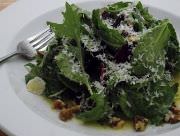Preventing Food Poisoning
Preventing food poisoning should be a priority in everyone's kitchen. Food poisoning isn't fun, I know this from personal experience. I've had it twice, back in my college days, once from a frozen dinner and once from a fast food restaurant. You know when and where you get it because a couple hours after you eat you start to develop this feeling in your gut. Not pleasant, not nice.
The good news is, so long as you are reasonably healthy you seem to make a fairly quick recovery.
I've said this before and I want to say it again, because it bears repeating, preventing food poisoning and food borne pathogens is a common sense kind of thing. Work clean, wash your hands frequently, wash your hands properly, clean and sanitize your work area and tools as needed, avoid cross contamination, store and cook your food properly, and for the love of god, wash your hands after you use the bathroom.
Preventing Food Poisoning Avoiding Food Borne Pathogens
Salmonella
Salmonella: The bacteria are not destroyed by freezing, they perish after being heated to 131 °F/55 °C for 90 min, or to 140 °F/60 °C for 12 min. To protect against Salmonella infection, heating food for at least ten minutes at 165 °F/74 °C is recommended, so that the centre of the food reaches 165° F/74° C.
You can learn more about salmonella at foodsafety.gov: Salmonella
Clostridium Perfringens
Clostridium Perfringens: also known as C. perfringens, is one of the most common causes of food poisoning in the US.
Prevention: Cook food thoroughly and keep it out of the danger zone, 40° F/4° C to 140 °F/60 °C.
You can learn more about Clostridium at foodsafety.gov: Clostridium
Botulism
Botulism: The toxin is destroyed by heating to more than 85 °C (185 °F) for greater than 5 minutes.
You can learn more about botulism at foodsafety.gov: botulism
E Coli 0157:H7
E Coli O157:H7: Ground beef and meat that has been needle-tenderized should be cooked to a temperature of at least 160°F/72° C.
You can learn more about E Coli at foodsafety.gov:E Coli
Trichinosis
Trichinosis: All meat can be safely prepared by cooking to an internal temperature of 165°F/74°C or higher for 15 seconds or longer.
Wild game: Meat must be cooked thoroughly. Freezing wild game does not kill all trichinosis larval worms. This is because the worm species, T. nativa, that typically infests wild game can resist freezing.
Unsafe and unreliable methods of cooking meat include the use of microwave ovens, curing, drying, and smoking.
You can learn more about Trichinosis at CDC: Trichinosis
Campylobacter
Campylobacter: It is one of the more common causes of food poisoning in the United States. Cook all foods thoroughly, prevent cross-contamination by washing and sanitizing cutting boards when handling raw and cooked foods. Wash raw fruit and vegetables before peeling, cutting or eating.
You can learn more about Campylobacter at foodsafety.gov: Campylobacter
Staphylococcus Aureus
Staphylococcus Aureus or Staph: It causes food poisoning by cross contamination. Particularly foods that are made with hand contact and do not require further cooking.
You can learn more about Staphylococcus at foodsafety.gov: Staphylococcus
Listeria Monocytogenes
Listeria Monocytogenes: This bacteria causes listeriosis—an infection that is very serious for older adults, pregnant women, young children and people with weakened immune systems. Unlike other food borne pathogens listeria can grow at refrigerator temperatures.
You can learn more about Listeria at foodsafety.gov: Listeria
Norovirus
Norovirus or Nowrwalk Virus: Norovirus is the leading cause of infection of the stomach and intestines in the US.
You can learn more about Norovirus at foodsafety.gov: Norovirus
Toxoplasma Gondii
Toxoplasma Gondii: It is a parasite that causes toxoplasmosis — a disease that is very serious for older adults, pregnant women, young children and people with weakened immune systems.
You can learn more about Toxoplasmosis at foodsafety.gov: Toxoplasma
Sources:
- Foodsafety.gov
- National Institute of Health
- Bing Images (License: free to use commercially)




